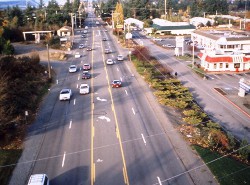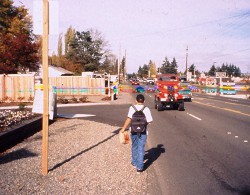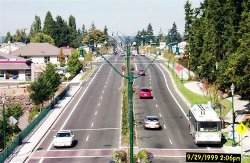Bridgeport Way: The Role of a Major Arterial in Town-Making
University Place, Washington
Source: Pedestrian and Bicycle Information Center (PBIC)
Problem
A one-mile section of Bridgeport Way in University Place, Washington, was the site of hundreds of traffic collisions between 1995 and 1998, many of which involved pedestrians. Besides being an area that has a history of safety issues for pedestrians, bicyclists and motorists, the road design and aesthetics contributed little to the city's economic development or sense of place.
Background

Bridgeport Way, prior to the redesign, bisects University Place's main commercial area.
Image Source: Debbie Klosowski
Bridgeport Way is a significant regional arterial that runs through the middle of University Place. Approximately 25,000 vehicles per day use the corridor, making Bridgeport Way the most heavily traveled roadway in the city. Prior to improvements, the 1.5-mile section that bisects University Place's main commercial area had five undivided traffic lanes (two in each direction and a two-way left-turn lane) with two-foot wide gravel shoulders that placed pedestrians close to vehicular traffic and did not offer operational space for bicyclists. Over 300 crashes occurred on this road section between 1996 and 1998, ten of which involved pedestrians and 91 resulted in injuries. In addition to the lack of sidewalks, insufficient lighting, absence of bicycle lanes, multiple access points, and speeding vehicles increased risk and created an unpleasant environment for nonmotorized users.
The City Council held a series of charrettes to identify residents' vision for the future. Creating a sense of place by developing a thriving, walkable downtown was one of the priorities citizens identified. Subsequently, the council approved a vision statement and goals for land use, economic development, and transportation that emphasized walking, bicycling, infill development, and aesthetic treatments for roads and developments.

Creating a walkable downtown was named as a top priority.
Image Source: Debbie Klosowski
A safer and more pleasant Bridgeport Way was essential to the council's plan for a walkable environment centered on a community gathering place. However, redesigning this major thoroughfare was both a political and physical challenge. The development team wrestled with these issues:
- Multiple access points on both sides of the road encouraged drivers to attempt left turns by crossing two busy lanes of traffic.
- Pedestrians attempted midblock crossings to access bus stops and short cuts.
- Parents with strollers, senior citizens, and schoolchildren walked along gravel shoulders next to busy traffic on the way to their destinations.
- There was limited recognition of bicyclists as legitimate road users, but the absence of bicycle lanes forced bicyclists to share space with cars.
- The absence of medians, landscaping, and other amenities contributed to a "speedway" feel along the road.
Solution
Countermeasures
In the summer of 1996, the City of University Place decided to design and construct safety improvements along a portion of Bridgeport Way. The proposed roadway design included the following design elements:
- Replace the existing two-way left-turn-lane with a raised, landscaped median that would prevent left turns out of driveways.
- Construct bicycle lanes and wide sidewalks on both sides of the roadway.
- Place planter strips on both sides of the road, between the sidewalk and bicycle lane.
- Install street lighting.
- Permit U-turns at the signalized intersections.
- Place utility lines underground.
Attracting private sector partners to help create a true downtown was a vital component of the community's vision. However, the City Council realized significant public improvements were needed along Bridgeport Way to jumpstart private investment in the area. The goals of the redesign project were to improve safety; increase mobility and cohesiveness; enhance the corridor; and control traffic growth.
After obtaining a grant from the Washington State Transportation Improvement Board, the city initiated an extensive public process to redesign Bridgeport Way. Outreach efforts included newspaper, television and website notices; fliers mailed to all property owners; posters; and overhead signs along Bridgeport Way. The resulting design process involved charrettes, public and neighborhood meetings, open houses, a Town Hall Meeting, and a public hearing before the City Council.
Following the public input process, the City Council chose the design option that included landscaped medians. Although access to local businesses was affected by construction of raised median islands, the Chamber of Commerce worked with the city to convince business owners that the new roadway would provide a much better business climate than the existing road. With this collaborative approach between the city and the Chamber of Commerce, most business owners donated the needed right-of-way to construct this project. The city spent less than $30,000 on right-of-way acquisition to obtain an average 10-foot strip of the front edge of each commercial property along the roadway. Without cooperation from the businesses, it would have cost the city $500,000 to obtain the right-of-way at fair market value.
University Place also worked with the local utility company to place utility lines underground. The utility company agreed to pay half of the cost, if the city could provide a utility trench as part of the city's construction project. This lowered the city's cost of relocating utility lines underground by as much as $1 million.
This section of Bridgeport Way was completed in 1999 at a total cost of $2.5 million, including design, right-of-way, and construction.
Later, from 1998 to 2002, a 1.5 mile section of Bridgeport Way was reconstructed in three phases at a cost of approximately $8.2 million. A road diet reduced travel lanes from five to four, replacing the center two-way left-turn lane with a raised, landscaped median that included street lighting. Planter strips along the corridor include streetlights that match the street lights in the median. Bicycle lanes and sidewalks were installed on both sides of the road. Other improvements included:
- Flared intersections to accommodate U-turns at traffic signals for improved access to businesses.
- Midblock pedestrian crossings with overhead signals.
- Overhead utility lines relocated underground.
- Enhancements such as decorative streetlights, hanging baskets, and a winding sidewalk that provides a visually pleasing walkway leading to a park near City Hall.
Results

Bridgeport Way after the redesign.
Image Source: Debbie Klosowski
The lane reduction along the corridor resulted in lower motor vehicle speeds and fewer midblock crashes, and the addition of bicycle lanes likely improved safety for bicyclists by separating them from motor vehicle traffic. Crashes have been reduced by about 60 percent and average traffic speeds have been reduced by about 13 percent. Despite greater pedestrian activity and exposure to vehicle traffic, pedestrian crashes did not increase.
The city has analyzed speed, collision, and economic development data collected before and after the construction of the Bridgeport Way improvements between 35th and 40th Streets. The project's traffic calming features reduced vehicle speeds and crashes while increasing business activity.
| Safety Measures | Before | After | Change |
|---|---|---|---|
| Change | 35 mi/h (6 km/h) | 35 mi/h (56 km/h) | Same |
| Average Actual Speed | 37.6 mi/h (1 km/h) | 32.6 mi/h (52 km/h) | -13 % |
| Average Annual Crashes | 19 | 8 (first year) | -60 % |
The project has benefited bicyclists by providing dedicated space and improving their comfort via the decrease in motor vehicle speed. Also, despite a dramatic increase in the level of pedestrian activity on the street and increased exposure to motor vehicle traffic, the frequency of pedestrian crashes has remained constant at about 2.5 crashes per year.
Physical changes along Bridgeport Way were instrumental in jumpstarting private sector economic development efforts. Public sector improvements include a new civic building, library, and parking garage. Studies indicated an increase in business revenues along the project corridor of approximately seven percent (citywide revenue increased five percent in the same period). Sales tax revenues along the corridor increased by 1.24 percent in 1997 (the year before construction), 7.73 percent in 1998, 5.64 percent in 1999, and 8.39 percent in 2000.
Costs
Approximately 20 percent of the Bridgeport Way project was paid for with local funds; 80 percent of the project was funded with grants from the Washington State Transportation Improvement Board, Washington State Department of Transportation, Puget Sound Regional Council, the Federal Highway Administration, and other agencies. Tacoma Public Utilities paid half the cost of relocating the utility lines underground. In addition, business owners along the corridor donated the needed right-of-way, a value of approximately $500,000.
| Phase 1A .5 miles | 1998-1999 | $2,215,103 for engineering, right of way, construction and inspection |
| Phase 1B .5 miles | 1999-2000 | $2,672,955 for engineering, right of way, construction and inspection |
| Phase 2 .5 miles | 2001-2002 | $3,348,458 for engineering, right of way, construction and inspection |
| Total cost | $8,236,516 |
Contact
Steve Sugg, Interim City Manager
City of University Place
3715 Bridgeport Way West
University Place, WA 98466
253-566-5656
ssugg@cityofup.com
www.cityofup.com




